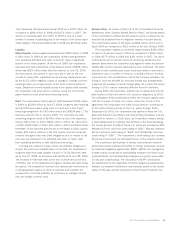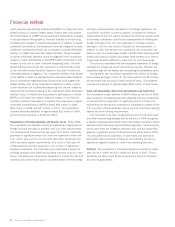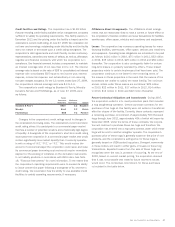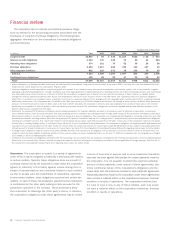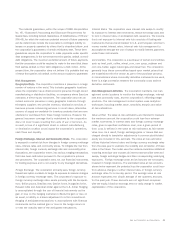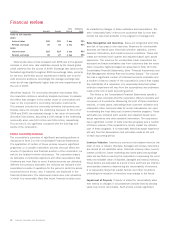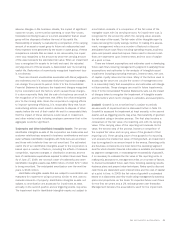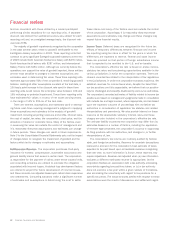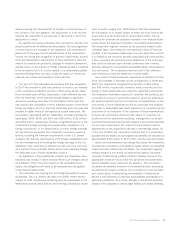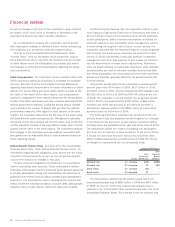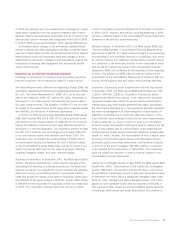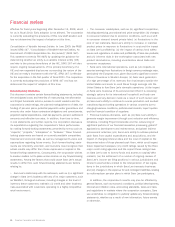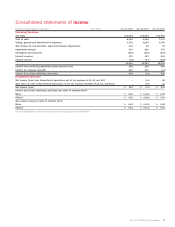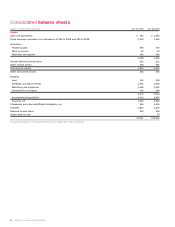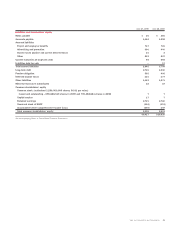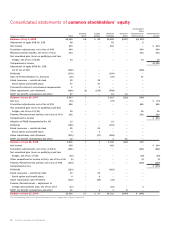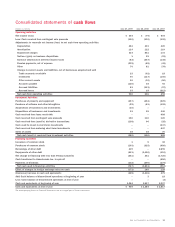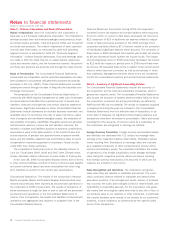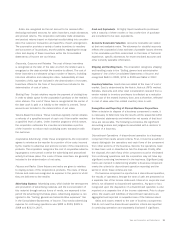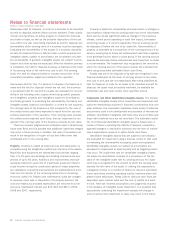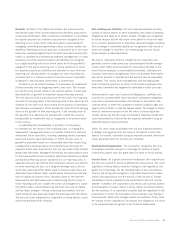Sara Lee 2009 Annual Report Download - page 47
Download and view the complete annual report
Please find page 47 of the 2009 Sara Lee annual report below. You can navigate through the pages in the report by either clicking on the pages listed below, or by using the keyword search tool below to find specific information within the annual report.in 2009 was primarily due to an actuarial loss resulting from actual
asset returns being less than the assumed long-term rate of return
partially offset by actuarial gains associated with an increase in the
discount rate used to measure plan obligations from 6.3% in 2008
to 6.5% in 2009 as well as amortization of the opening deferred loss.
As indicated above, changes in the bond yields, expected future
returns on assets, and other assumptions can have a material impact
upon the funded status and the net periodic benefit cost of defined
benefit pension plans. It is reasonably likely that changes in these
external factors will result in changes to the assumptions used by the
corporation to measure plan obligations and net periodic benefit
cost in future periods.
Issued but not yet Effective Accounting Standards
Following is a discussion of recently issued accounting standards
that the corporation will be required to adopt in a future period.
Fair Value Measurements
Effective the beginning of fiscal 2009, the
corporation implemented Financial Accounting Standards Board (FASB)
No. 157, “Fair Value Measurements” (SFAS 157), for its financial
assets and liabilities. SFAS 157 defines fair value, establishes a
framework for its measurement, and expands disclosures about
fair value measurements. The adoption of SFAS 157 did not have
an impact on the measurement of the corporation’s financial assets
and liabilities, but did result in additional disclosures.
In 2007, the Financial Accounting Standards Board (FASB) issued
FASB Staff Position FAS 157-2 (FSP 157-2), which provided a one
year deferral for the implementation of SFAS 157 for non-financial
assets and liabilities measured at fair value that are recorded or
disclosed on a non-recurring basis. The corporation elected to apply
the FSP 157-2 deferral, and accordingly, will not apply SFAS 157
to its non-financial assets and liabilities until fiscal 2010. The
corporation does not believe the implementation of SFAS 157 for
our non-financial assets and liabilities will have a material impact
on the Consolidated Financial Statements, but we do expect it will
impact the way we determine the fair value of goodwill, indefinite
long-lived intangible assets, and other long-lived assets.
Business Combinations
In December 2007, the FASB issued SFAS
141(R), “Business Combinations,” which requires changes in the
accounting and reporting of business acquisitions. The statement
requires an acquirer to recognize the assets acquired, the liabilities
assumed, and any noncontrolling interest in purchased entities,
measured at their fair values at the date of acquisition based upon
the definition of fair value outlined in SFAS No. 141(R). SFAS 141(R)
is effective for the corporation for acquisitions that occur beginning
in 2010. The corporation believes that there will be no impact
on the Consolidated Financial Statements at the date of adoption
of SFAS 141(R). However, acquisitions occurring beginning in 2010
will have a different impact on the Consolidated Financial Statements
compared to the previous accounting rules.
Minority Interests
In December 2007, the FASB issued SFAS 160,
“Noncontrolling Interests in Consolidated Financial Statements an
Amendment of ARB No. 51,” which requires changes in the accounting
and reporting of noncontrolling interests in a subsidiary, also known
as minority interest. The statement clarifies that a minority interest
in a subsidiary is an ownership interest in the consolidated entity
that should be reported as equity in the consolidated financial
statements. SFAS 160 is effective for the corporation at the beginning
of 2010. The adoption of SFAS 160 will have an impact on the
presentation of the Consolidated Statements of Income in that net
income will be reported with and without noncontrolling interests.
Employers’ Disclosures about Postretirement Benefit Plan Assets
In December 2008, the FASB issued FASB Staff Position No. FAS
132(R)-1 (FSP FAS 132(R)-1), “Employers’ Disclosures about
Postretirement Benefit Plan Assets,” which expands the disclosure
requirements about plan assets for pension plans, postretirement
medical plans, and other funded postretirement plans. Specifically,
the rules require disclosure of: i) how investment allocation decisions
are made by management; ii) major categories of plan assets; iii)
significant concentrations of credit risk within plan assets; iv) the
level of the fair value hierarchy in which the fair value measurements
of plan assets fall (i.e. level 1, level 2 or level 3); v) information
about the inputs and valuation techniques used to measure the fair
value of plan assets; and vi) a reconciliation of the beginning and
ending balances of plan assets valued with significant unobservable
inputs (i.e. level 3 assets). The reconciliation of level 3 assets shall
be broken out by realized gains/losses, unrealized gains/losses,
purchases, sales, accounting settlements, and transfers of assets
in and out of the level 3 category. FSP FAS 132(R)-1 is required
to be adopted by the corporation in fiscal 2010. The corporation
does not expect the adoption to have a material impact on the
Consolidated Financial Statements.
Useful Life of Intangible Assets
In April 2008, the FASB issued Staff
Position No. 142-3, “Determination of the Useful Life of Intangible
Assets” (FSP142-3). This position amends the factors that should
be considered in developing renewal or extension assumptions used
to determine the useful life of a recognized intangible asset under
SFAS No. 142, “Goodwill and Other Intangible Assets.” FSP 142-3
applies to both intangible assets that are acquired individually or
with a group of other assets as well as intangible assets acquired
in business combinations and asset acquisitions. This position is
Sara Lee Corporation and Subsidiaries 45


